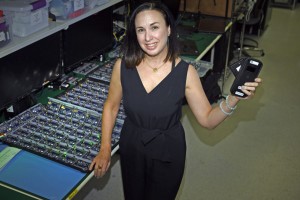 The Future of IoT in Keeping Food Fresh: Laura Rumbel, Consumer Experience Enabling Director in Intel’s Internet of Things Group, Explains How IoT Reduces Food Supply Waste and Theft, and Helps Combat Foodborne Illness
The Future of IoT in Keeping Food Fresh: Laura Rumbel, Consumer Experience Enabling Director in Intel’s Internet of Things Group, Explains How IoT Reduces Food Supply Waste and Theft, and Helps Combat Foodborne Illness
Our expert: Laura Rumbel works with Intel’s customers to make IoT-based supply chain solutions that provide real-time data. That data allows enterprises to make decisions as food shipments are in transit and better predict the future needs of their supply chain.
Her simple explanation of IoT’s promise in the food supply chain: Every year $400 billion of food in production never reaches consumers, according to Bloomberg. “There is a major disparity between the amount of food that’s never consumed versus the number of hungry people worldwide,” Rumbel says. “This is where IoT comes into play.”
The power of data: Intel recently partnered with a produce distributor to help maximize efficiency and create less waste by tracking blueberries from harvest to the distribution center. Intel’s IoT-based sensors tracked the berries’ temperature, humidity, shock (which monitors damage, like being dropped) and changes in light (which indicate a pallet is being tampered with). Even a slight change in temperature can significantly affect the quality of the fruit. “Instead of berries going to waste if they are overripe, they can be sent to a consumer that can use the berries to make juice,” Laura says. Real-time data allows these decisions to be made quickly, before the berries spoil — ultimately saving time and money, and protecting consumers’ health.
Safety is key: Another benefit of IoT in the food supply chain is the early identification of foodborne illness. Outbreaks affect individuals and the entire industry. Not only are people getting sick, but others hear about the outbreak and stop buying the product altogether — even though the contaminant is coming from a particular source, not the industry at large. However, it can take a lot of valuable time and energy to track down a foodborne illness’ origin. “If you use the sensors to tag your produce from the lot where it was harvested and follow that all the way through to the store where it was purchased, that’s where you’re golden,” Laura explains. “Because if that product is tagged and it’s sitting in a distribution center, or even if it goes all the way through to the store — say it’s recalled in a listeria-like situation — you immediately know. You have all the data that you need in the cloud.”
Saving food and stopping thieves: Real-time data can also help enterprises provide a safer environment for drivers transporting goods and for the goods themselves. Theft is a major risk facing the supply chain industry, with $33 million worth of goods stolen from cargo in 2018 alone, according to the FBI. In response, Intel created the Castle Canyon Mobile Platform, which uses a light sensor to help identify cases of theft in real-time. For example, if a pallet is being tampered with, the sensors will detect the abnormal activity and immediately notify staff, who can then alert the driver and potentially local law enforcement.
Future-focused: Though the uses of IoT sensors and tracking software are currently focused on enterprises, Laura believes they have the potential to revolutionize consumers’ purchasing decisions by allowing them to trace their products through the entire supply chain. “Retailers are trying to grapple with the power of the consumer because ultimately consumers care more than ever before about the ethics and sustainability of products,” Laura says. “Consumers want to make their own decisions; they want access to the data.” But, she points out, it’s important for the data to be broken down and contextualized for the consumer to make meaning of the raw data. Informed consumers will be able to decide whether the product aligns with their values — which can reinforce trust with consumers of that brand.


